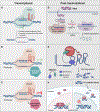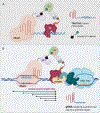Targeted protein degradation: A promise for undruggable proteins
- PMID: 34004187
- PMCID: PMC8286327
- DOI: 10.1016/j.chembiol.2021.04.011
Targeted protein degradation: A promise for undruggable proteins
Abstract
Protein homeostasis, or "proteostasis," is indispensable for a balanced, healthy environment within the cell. However, when natural proteostasis mechanisms are overwhelmed from excessive loads of dysregulated proteins, their accumulation can lead to disease initiation and progression. Recently, the induced degradation of such disease-causing proteins by heterobifunctional molecules, i.e., PROteolysis TArgeting Chimeras (PROTACs), is emerging as a potential therapeutic modality. In the 2 decades since the PROTAC concept was proposed, several additional Targeted Protein Degradation (TPD) strategies have also been explored to target previously undruggable proteins, such as transcription factors. In this review, we discuss the progress and evolution of the TPD field, the breadth of the proteins targeted by PROTACs and the biological effects of their degradation.
Keywords: PROTACs; proteasome; targeted protein degradation; ubiquitination; undruggable proteome.
Copyright © 2021 Elsevier Ltd. All rights reserved.
Conflict of interest statement
Declaration of interests C.M.C is founder, shareholder, and consultant to Arvinas, Inc. and Halda, LLC, which support research in his laboratory.
Figures






References
-
- ADHIKARI B, BOZILOVIC J, DIEBOLD M, SCHWARZ JD, HOFSTETTER J, SCHRÖDER M, WANIOR M, NARAIN A, VOGT M, DUDVARSKI STANKOVIC N, BALUAPURI A, SCHÖNEMANN L, EING L, BHANDARE P, KUSTER B, SCHLOSSER A, HEINZLMEIR S, SOTRIFFER C, KNAPP S & WOLF E. 2020. PROTAC-mediated degradation reveals a non-catalytic function of AURORA-A kinase. Nature Chemical Biology, 16, 1179–1188. - PMC - PubMed
-
- AHN IE, UNDERBAYEV C, ALBITAR A, HERMAN SEM, TIAN X, MARIC I, ARTHUR DC, WAKE L, PITTALUGA S, YUAN CM, STETLER-STEVENSON M, SOTO S, VALDEZ J, NIERMAN P, LOTTER J, XI L, RAFFELD M, FAROOQUI M, ALBITAR M & WIESTNER A. 2017. Clonal evolution leading to ibrutinib resistance in chronic lymphocytic leukemia. Blood, 129, 1469–1479. - PMC - PubMed
-
- ANTONARAKIS ES, LU C, WANG H, LUBER B, NAKAZAWA M, ROESER JC, CHEN Y, MOHAMMAD TA, CHEN Y, FEDOR HL, LOTAN TL, ZHENG Q, DE MARZO AM, ISAACS JT, ISAACS WB, NADAL R, PALLER CJ, DENMEADE SR, CARDUCCI MA, EISENBERGER MA & LUO J. 2014. AR-V7 and resistance to enzalutamide and abiraterone in prostate cancer. N Engl J Med, 371, 1028–38. - PMC - PubMed
Publication types
MeSH terms
Substances
Grants and funding
LinkOut - more resources
Full Text Sources
Other Literature Sources

